We already wrote about why you need grounding in the apartment, and what to do if your apartment building it is not. Now let’s deal with the peculiarities of the ground in private homes. Perhaps the main difference of this circuit is the need of insurance.

OOO GeoGraffiti
Grounding does not happen much
As in apartment houses, private houses there are three kind of wiring. In older homes — two-wire network system TN-C, new three wire TNC-S or TT system with grounded zero and independent of the grounding circuit. However, to turn “old” into “new” in a private home is much easier than in the apartment. You do not need to contact the management company and ask it to upgrade the wiring during regular maintenance. And especially not have to wait when will be the turn of the overhaul. Install grounding in a private house it is possible on an individual basis. Most importantly, know how to act correctly.
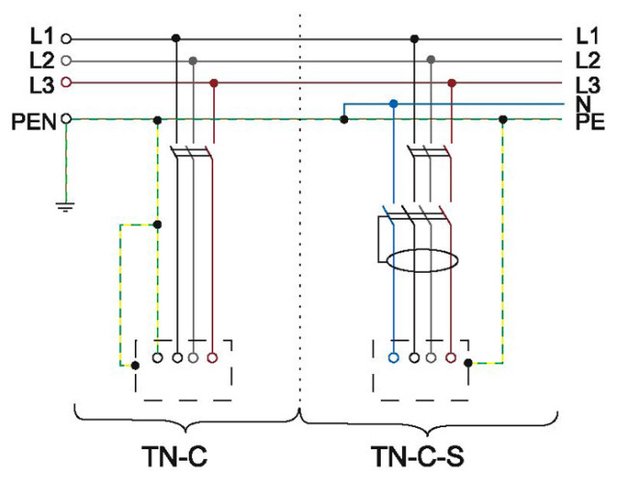
Scheme of the website aquatic-home.ru
Village electricians often just put them on the ground a piece of steel angle or armature, to which is connected the copper wire. Yes, as an additional ground, this design possible. But for full ground loop it is not enough.
Requires special attention to wiring made by the system earthing TT (in the diagram below). With this connection to the ground circuit on your site will be subject to increased requirements: needs to be not one but at least two or three electrodes. After all, unlike the previous variants, here he is forced to “cope” with the work on their own, no doubles — that is, repeated groundings on the way from the transformer substation to the load.

Scheme of the website housediz.ru
How many phases should enter the house?
Connection in a private home may be single phase (as in the diagram above) and three — phase, in this case, you “take” electricity from local network, not with two but with three wires. For small networks with dedicated capacity of 15 kW the last option is a bit expensive, but for the developed of the household is preferable.
First, it allows to use the equipment requiring connections to three phase sockets (electric boilers, electric stoves, stoves for saunas, woodworking machines).
Second, when properly designed power supply scheme allows to minimise voltage dips on the network when you turn on powerful devices.
Third, in a three-phase network can be evenly distributed load: phase in, phase in the bath, all three in the garage and workshop.
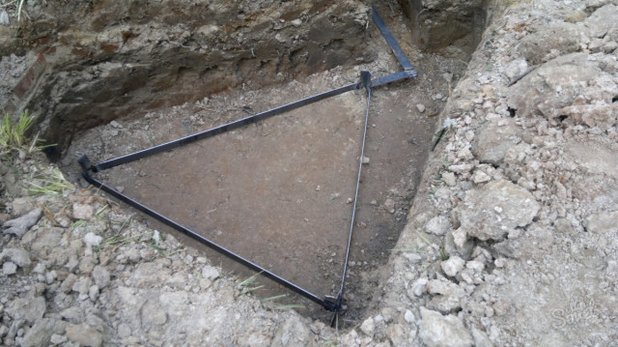
Photo from chebo.biz
How to make grounding in a private house?
The earthing for the mains has an identical structure, regardless of the number of phases. Moreover, a ground loop like a private house with 15 kW is needed for lightning protection system. Here two variants are possible.
1. Use as a grounding conductor buried or driven into the ground conductors: steel wire, area, etc. Fit two or three metal rods, United welded crosspiece. The rods feature a contour in the shape of a triangle at a distance of not less than three meters from each other. The depth of the ground — 2-3 m. In this case the jumper between the bars should be placed a little lower than half a meter under the ground. To one of the crosspieces are welded to the current collector made of steel wire, which appears on the surface.
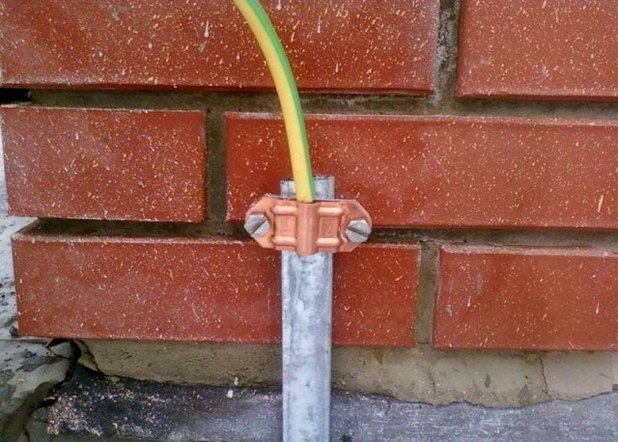
Photo from amperof.ru
Important: For the underground part of this design is valid only weld as any other (e.g., screwed) in the ground corrode and lose their reliability. Copper wire from the home panel is connected to the current collector with clamping terminals. Clip always treated with anti-corrosive grease.
For more detail about how to make grounding in a private house (and what it should be), we wrote in the article about lightning protection. Make sure that the village electrician knows these details before you connect the grounding plate.
ON THE SUBJECT…
Question: Why do you need lightning protection
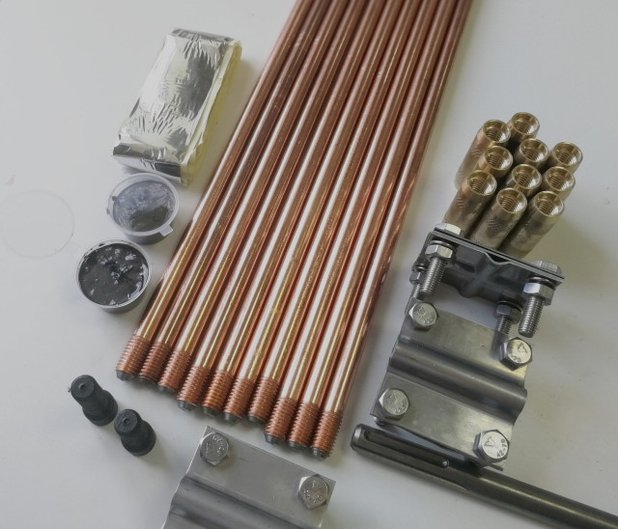
Photo from zazem812.ru
2. Ready to buy a kit in the form of a set of steel rods (there are more expensive, made of copper or stainless steel) and contact groups. The advantage of “box” solutions — reliable contacts, quick installation of the grounding system and an increased service life: copper and stainless steel to serve for many decades.
For private homes in Central Russia with a traditionally high level of groundwater is usually sufficient. Earthing switches maintenance — only periodic (every two to three years) examination of the external contact groups, and if required, cleaning and lubricating contacts.
To know or check whether the grounding in a private house, just like in the apartment.
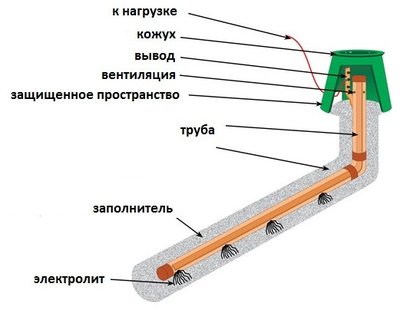
Photo from elektro.ru
Complex case: Electrolytic grounding
Electrolytic grounding — it is also “boxed” solution, but it is designed for soils with high electrical resistance (e.g., to ground in dry, sandy soil), places where it is not possible to bury in the ground (rock base), and with limited space (high density development).
As the grounder here we use L-shaped hollow rod or electrode, which is filled with specially prepared mixture of mineral salts.
However, if your home is not located in the desert or permafrost, electrolytic grounding is unnecessary. Its main application field — industrial features.

James Martin Associates
Single earthing for the electrical and lightning protection system — so it is possible?
Let’s just say, the rules do not prohibit it. But there is an important point: to do grounding right “at home” — is impossible. Earthing lightning protection system should be located at a distance greater than 5 m from the entrance to the house, paths and tracks. Further 1.5 m from the foundations of buildings. At the same time in a thunderstorm to approach him dangerous. If the lightning protection system struck by lightning, it creates an electrical pulse voltage of up to hundreds of kilovolts. May occur uncontrolled currents that can bring down appliances and even cause a fire.
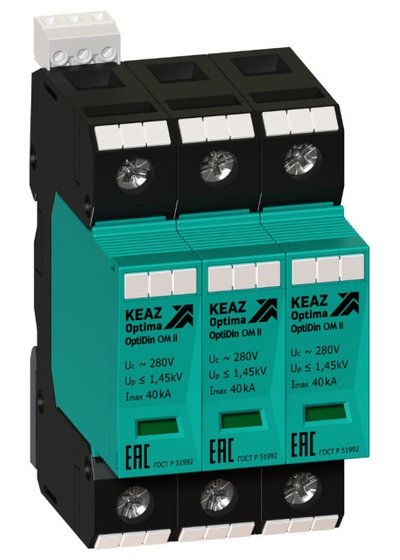
Photo from keaz.ru
Tip: to Prevent unwanted effects will help to install at the entrance flap of the device of the surge protection (SPD). It is mounted on a DIN rail, looks the same as an RCD (residual current device), is worth several thousand. But the repair of burned equipment or eliminate the consequences of fire will cost much more.
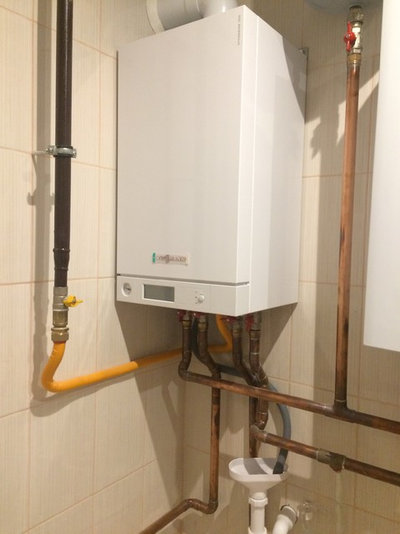
CityRoof
What ground, except the wiring?
Unlike apartment buildings where the ground requires only wiring in private buildings, there are other elements that need to be connected to the grounding circuit. For example, a gas boiler and a metal pipe system, gas heating. The latter must be connected with potential equalization system (CPS). The question how to make grounding of the gas boiler, Express installers of the equipment. The Amateur has no place here.
Representatives of gas companies to meet their (increased) requirements for the quality of grounding. The main indicator of good work of earthing — resistance to flow of electric current. The standard value for a private household — no more than 30 Ohms (measured right at the point of location of the grounding, “home” means don’t check). Grounding, made in the schemes that we described earlier, this value is associated with. If your circuit is not “up” to the high demands of gas (not more than 10 Ohms) will likely have to do additional grounding point.

Julia Juicin
Don’t forget the ouzo!
No matter what kind of grounding is done in your home, a safety net in case his “misfire” put separate RCD on the outgoing line to the emergency situation in the bath, in the garage or on the street with the mower — you do not “cut down” the whole house.
Special attention should be given to outlets in rooms of high humidity (bathrooms, dressing room, ground floor). Keep in mind that they can only install sockets specially designed for outdoor installation in splash-proof design (with caps). Namely, the minimum protection class — IP54 (indoor), IP65 (street), with earthing contact, connect only through the RCD.

Workshop brothers Titov
IT’S YOUR TURN…
Tell us, what are the nuances of grounding in a holiday home you have learned from experience. Share in the comments!
















